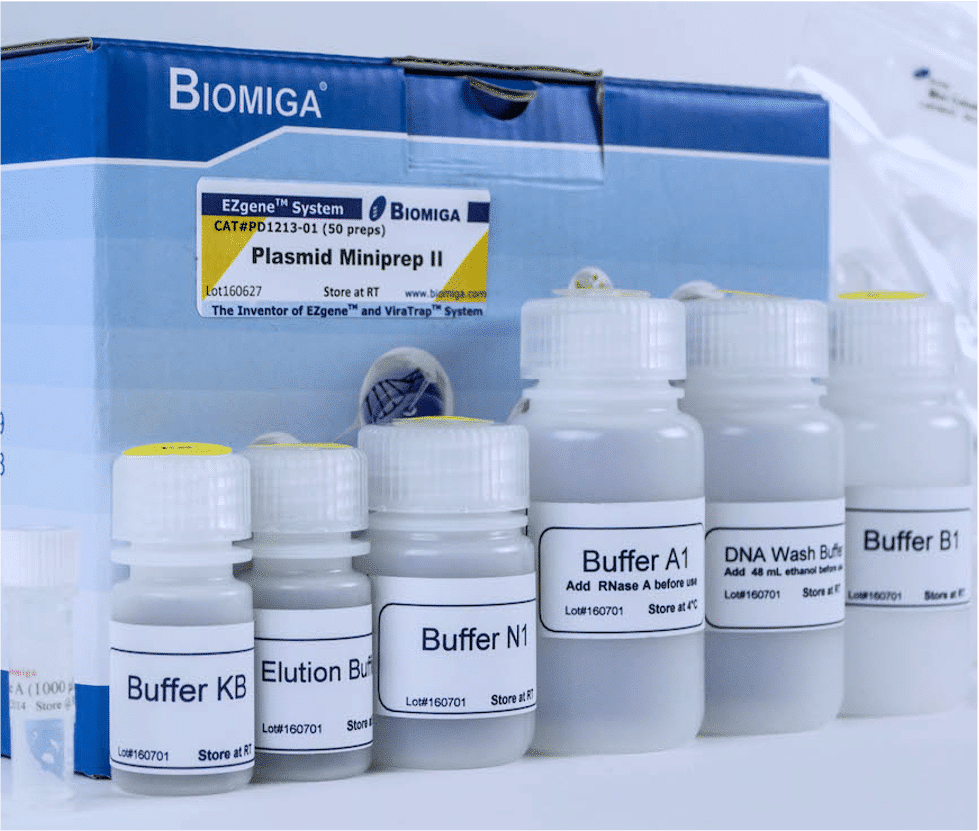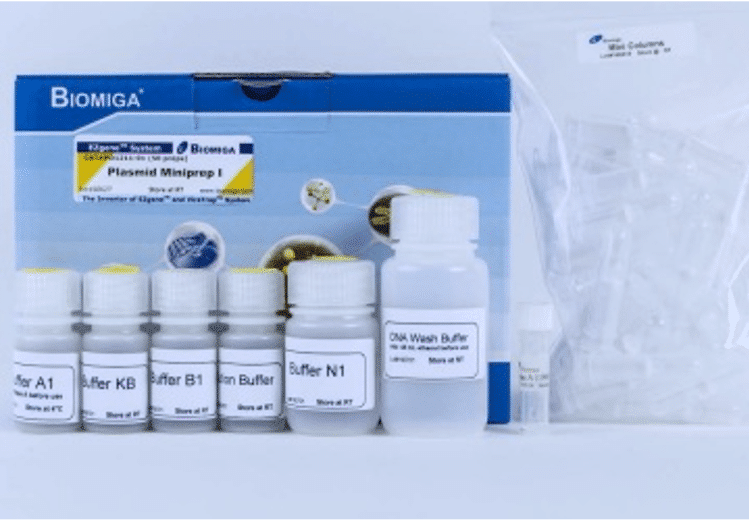Plasmid Miniprep Kit II
$18.00 – $280.00
Plasmid Miniprep Kit II
Buffer A1, B1, N1, KB, DNA Washing Buffer, Elution Buffer, RNase A, ezBind Columns(50), User Manual(1)
Introduction
Key to the kit is our proprietary DNA binding systems that allow the high efficient binding of DNA to our ezBindTM matrix while proteins and other contaminants are removed under certain optimal conditions. Nucleic acids are easily eluted with sterile water or Elution Buffer.
This kit is designed for fast and efficient purification of plasmid DNA from 1 to 15 mL of E. coli culture. With the binding capacity of 80 ?g, the yield obtained by Miniprep Kit II (PD1213) is higher than Miniprep Kit I (PD1211). ?The yield from 1 mL culture is typically around 8 to 12 ?g. ?
The purified DNA is ready for downstream applications such as cloning/subcloning, RFLP, sequencing, and transfection of HEK293 cells.
Important Notes
Plasmid Copy Numbers: The yield of plasmid DNA depends on the origin of the replication and the size of the plasmid. The protocols are optimized for high copy number plasmid purification. For low copy number plasmids, both the culture volume and the buffer volume need to be scaled up 3 to 5 times. Please reference Table 1 for the commonly used plasmids,
Table 1 commonly used plasmid and expected yield.
|
Plasmid |
Origin |
Copy Numbers |
Expected Yield(?g per 1 mL) |
|
pSC101 |
pSC101 |
5 |
0.1-0.2 |
|
pACYC |
P15A |
10-12 |
0.4-0.6 |
|
pSuperCos |
pMB1 |
10-20 |
0.4-1 |
|
pBR322 |
pMB1 |
15-20 |
0.6-1 |
|
pGEMR |
Muted pMB1 |
300-400 |
6-7 |
|
pBluescriptR |
ColE1 |
300-500 |
6-8 |
|
pUC |
Muted pMB1 |
500-700 |
8-12 |
Host Strains: The strains used for propagating plasmid have significant influence on yield. Host strains such as Top 10 and DH5a yield high-quality plasmid DNA. endA+ strains such as JM101, JM110, HB101, TG1 and their derivatives, normally have low plasmid yield due to either endogenous endonucleases or high carbohydrates released during lysis. We recommend transform plasmid to an endA- strain if the yield is not satisfactory.
Table2 endA- strains of E. Coli.
|
EndA- Strains of E. Coli |
||||||||||||||
|
DH5α |
DH1 |
DH21 |
JM106 |
JM109 |
SK2267 |
SRB |
XLO |
|||||||
|
TOP10 |
DH10B |
JM103 |
JM107 |
SK1590 |
MM294 |
Stbl2TM |
XL1-Blue |
|||||||
|
BJ5182 |
DH20 |
JM105 |
JM108 |
SK1592 |
Select96TM |
Stbl4TM |
XL10-Gold |
|||||||
|
EndA+ Strains of E. Coli |
||||||||||||||
|
C600 |
JM110 |
RR1 |
ABLE? C |
CJ236 |
KW251 |
P2392 |
BL21(DE3) |
|||||||
|
HB101 |
TG1 |
TB1 |
ABLE? K |
DH12STM |
LE392 |
PR700 |
BL21(DE3)pLysS |
|||||||
|
JM101 |
JM83 |
TKB1 |
HMS174 |
ES1301 |
M1061 |
Q358 |
BMH 71-18 |
|||||||
|
All NM ?strains |
All Y strains |
|||||||||||||
Optimal Cell Mass (OD600 x mL of Culture): This procedure is designed for isolating plasmid grown in standard LB medium (Luria Bertani) for 12 -16 hours to a density of OD600 2.0 to 3.0. If rich mediums such as TB or 2xYT are used, make sure the cell density doesn't exceed 3.0 (OD600). A high ratio of biomass over lysis buffers result in low DNA yield and purity. The mini column has an optimal biomass of 30-45. For example, if the OD600 is 3.0, the optimal culture volume should be 10-15 mL. For over amount of cell numbers, either reduce the biomass or scale up the volumes of Buffer A1, B1 and N1.
Culture Volume: Use a flask or tube 4 times bigger in volumn thanthe culture medium to secure optimal condition for bacteria growth. Don't exceed the maximum culture volume suggested in the protocol. Incomplete lysis due to over amount of bacterial culture results in lower yield and less purity.
Storage and Stability
Buffer A1 should be stored at 4?C once RNase A is added. All other materials can be stored at room temperature (22-25?C). The Guaranteed shelf life is 12 months from the date of purchase.
Before Starting
Prepare all components and get all necessary materials ready by examining this instruction booklet and become familiar with each steps.
Important
- RNase A: It is stable for more than half a year when stored at room temperature. Spin down RNase A vial briefly. Add the RNase A solution to buffer A1 and mix well before use. Store at 4?C.
- Add 8 mL (PD1213-00) or 60 mL (PD1213-01) or 60 mL (PD1213-02) or 96 mL (PD1213-03) 96-100% ethanol to each DNA Wash Buffer bottle before use.
- Buffer B1 precipitates below room temperature. It is critical to warm up the buffer at 50?C to dissolve the precipitates before use.
- Keep the cap tightly closed for Buffer B1 after use.
- Ensure the availability of centrifuge capable of 13,000 rpm.
- Carry out all centrifugations at room temperature.
Materials supplied by users
- 96-100% ethanol
- 1.5 mL, 2.0 mL microcentrifuge tubes.
- 15 mL conical tubes.
- High speed microcentrifuge or Vacuum manifold.
Kit Contents
|
Catalog# |
PD1213-00 |
PD1213-01 |
PD1213-02 |
PD1213-03 |
|
Preps |
4 |
50 |
100 |
250 |
|
ezBind Columns |
4 |
50 |
100 |
250 |
|
Buffer A1 |
2.5 mL |
25 mL |
50 mL |
125 mL |
|
Buffer B1 |
2.5 mL |
25 mL |
50 mL |
125 mL |
|
Buffer N1 |
3 mL |
30 mL |
60 mL |
135 mL |
|
Buffer KB |
3 mL |
30 mL |
60 mL |
135 mL |
|
DNA Wash Buffer* |
2 mL |
15 mL |
2 x 15 mL |
3 x 24 mL |
|
Elution Buffer |
1 mL |
15 mL |
30 mL |
60 mL |
|
RNase A (20 mg/mL) |
0.25 mg(12.5 ?L) |
2.5 mg(125 ?L) |
5 mg(250 ?L) |
12.5 mg(625 ?L) |
|
User Manual |
1 |
1 |
1 |
1 |
*Add 8 mL (PD1213-00) or 60 mL (PD1213-01) or 60 mL (PD1213-02) or 96 mL (PD1213-03) 96-100% ethanol to each DNA Wash Buffer bottle before use.
Safety Information
- Buffer N1 contains acidic acid, wear gloves and protective eyewear while handling.
- Buffer N1 and KB contains chaotropic salts, which may form reactive compounds when combines with bleach. Do not add bleach or acidic solutions directly to the preparation waste.
Operating Protocol
Documents:
Back to Product Category:




Reviews
There are no reviews yet.